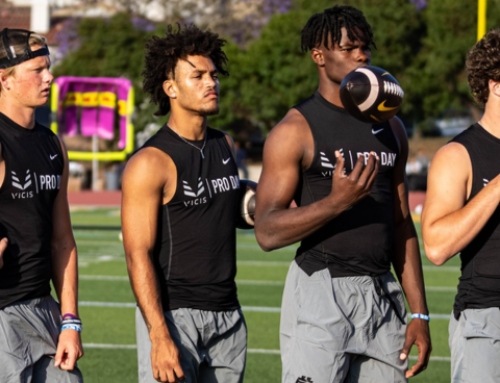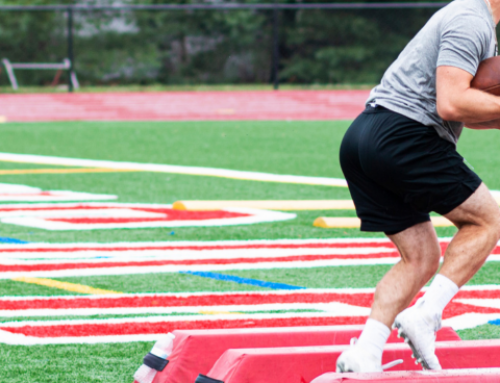Why Position-Specific Training is Crucial for Football Players
To improve as a player in the off-season, you have to be specific and purposeful about your training.
Football players must identify specific movements that translate directly to their position and work to become more consistently explosive with those movements.
At Chip Smith Performance, we’ve trained quarterbacks Cam Newton, Colin Kaepernick, Jay Cutler, and, most recently, South Carolina QB Connor Shaw.
As Connor trains for the NFL, we try to be specific on the movements he will be using in a game, like the drills we do to work specifically on his three-step, five-step and seven-step drops, as well as redirection in and out of the pocket.
In these drills, we work to make a quarterback as explosive as possible with his first step from under center, and then work to have him hit the third, fifth and seventh steps quickly and efficiently.
A quarterback’s ability to execute dropbacks quickly gives him more time to see, react to and read the defense, go through his progressions, and deliver the football on time to his receivers.
In order to accomplish this, we use resistance, overspeed and reaction training techniques to recruit and build fast-twitch muscle fibers in that specific movement pattern.
A gain of a mere few tenths of a second to a quarterback’s dropback to hit his third, fifth or seventh step can be the difference between a critical completion or a sack.
For your off-season training program, isolate the fundamental movements that are critical to making you being the best player you can be at your position and apply resistance, reaction and over-speed training techniques to that movement to make yourself more explosive for the season.
A cornerback, for example, should focus on improving his foot speed to get in and out of his backpedal and into his break to cover a wide receiver. Offensive linemen, on the other hand, are required to make entirely different movements. They must work on being explosive with their pass sets, zone blocks, trapping and pulling movements.
In the NFL, it’s all about the “little things,” not just about getting guys “bigger, faster and stronger.” It’s about making players better and more explosive at what they are actually doing on the field.
Editor’s note: See how Smith incorporated position-specific drills into the off-season training program for former Chicago Bears All-Pro LB Brian Urlacher.
Train movement specific and position specific, and watch your work in the off-season translate to the field during to make you a better player all season.
RECOMMENDED FOR YOU
MOST POPULAR
Why Position-Specific Training is Crucial for Football Players
To improve as a player in the off-season, you have to be specific and purposeful about your training.
Football players must identify specific movements that translate directly to their position and work to become more consistently explosive with those movements.
At Chip Smith Performance, we’ve trained quarterbacks Cam Newton, Colin Kaepernick, Jay Cutler, and, most recently, South Carolina QB Connor Shaw.
As Connor trains for the NFL, we try to be specific on the movements he will be using in a game, like the drills we do to work specifically on his three-step, five-step and seven-step drops, as well as redirection in and out of the pocket.
In these drills, we work to make a quarterback as explosive as possible with his first step from under center, and then work to have him hit the third, fifth and seventh steps quickly and efficiently.
A quarterback’s ability to execute dropbacks quickly gives him more time to see, react to and read the defense, go through his progressions, and deliver the football on time to his receivers.
In order to accomplish this, we use resistance, overspeed and reaction training techniques to recruit and build fast-twitch muscle fibers in that specific movement pattern.
A gain of a mere few tenths of a second to a quarterback’s dropback to hit his third, fifth or seventh step can be the difference between a critical completion or a sack.
For your off-season training program, isolate the fundamental movements that are critical to making you being the best player you can be at your position and apply resistance, reaction and over-speed training techniques to that movement to make yourself more explosive for the season.
A cornerback, for example, should focus on improving his foot speed to get in and out of his backpedal and into his break to cover a wide receiver. Offensive linemen, on the other hand, are required to make entirely different movements. They must work on being explosive with their pass sets, zone blocks, trapping and pulling movements.
In the NFL, it’s all about the “little things,” not just about getting guys “bigger, faster and stronger.” It’s about making players better and more explosive at what they are actually doing on the field.
Editor’s note: See how Smith incorporated position-specific drills into the off-season training program for former Chicago Bears All-Pro LB Brian Urlacher.
Train movement specific and position specific, and watch your work in the off-season translate to the field during to make you a better player all season.










